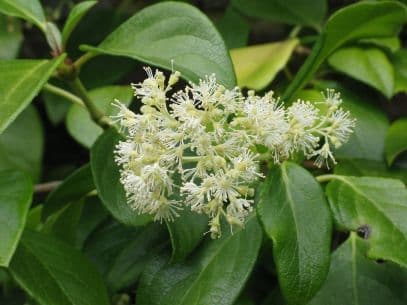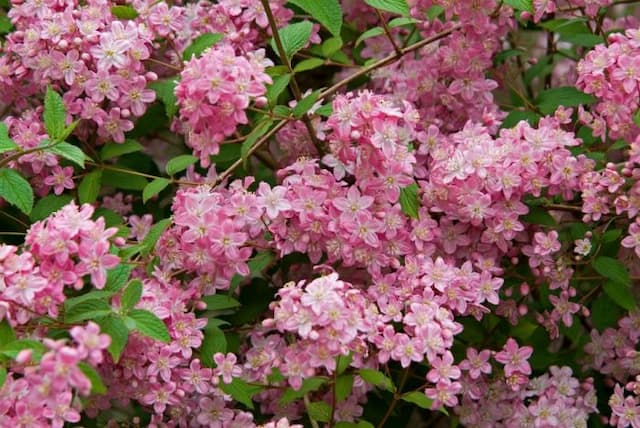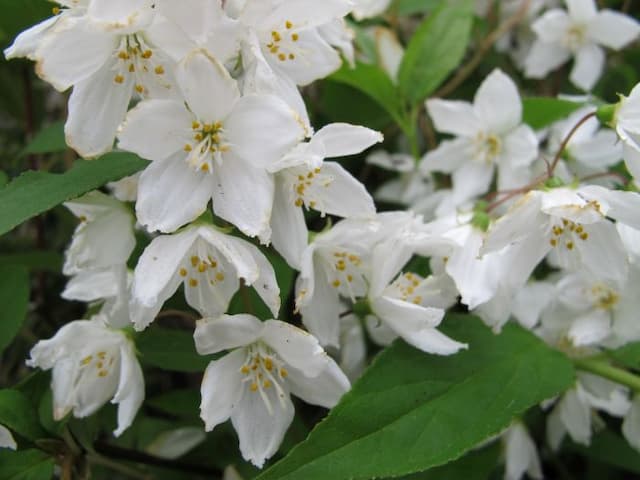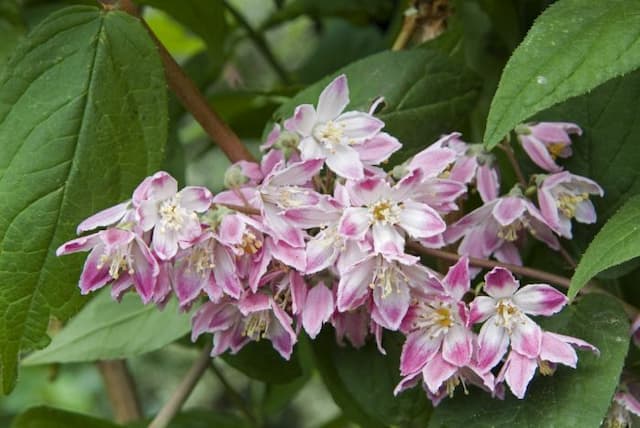Hydrangea macrophylla 'Setsuka-yae' (L/d)

ABOUT
Hydrangea macrophylla 'Setsuka-yae' is commonly known as the bigleaf hydrangea. It has a lush, bushy appearance with broad, deep green leaves that create a striking backdrop for its flowers. The plant is renowned for its large, showy blooms which often have a mophead form – spherical clusters of flowers that can create quite a visual impact. These blooms can display a range of colors including shades of pink, blue, purple, and sometimes even a mix of these hues, often depending on the soil pH. The flowers usually appear in the summer and can persist into the fall, offering a long season of interest. The leaves are thick and somewhat glossy, with a texture that can feel a bit leathery. They are usually oval-shaped with serrated edges, contributing to the overall lushness of the plant. When in bloom, the clusters of flowers sit prominently above the foliage, making them a focal point of the plant. In terms of its growth habit, the bigleaf hydrangea has a tendency to spread, with branches that can arch gracefully under the weight of the flowers. This characteristic contributes to the plant's full and rounded look, which makes it a popular choice for gardeners seeking to add volume and a splash of color to their landscape. The stems of the plant are sturdy, helping to support both the weight of the leaves and the heavy flower heads. Overall, the bigleaf hydrangea 'Setsuka-yae' is a plant with a visually appealing form and captivating flowers that can add a romantic and lush feel to gardens and outdoor spaces.
About this plant
 Names
NamesFamily
Hydrangeaceae
Synonyms
Bigleaf Hydrangea, French Hydrangea, Lacecap Hydrangea, Mophead Hydrangea, Hortensia
Common names
Hydrangea macrophylla 'Setsuka-yae'.
 Toxicity
ToxicityTo humans
Hydrangea, including the Hydrangea macrophylla 'Setsuka-yae', can be toxic to humans if ingested. The plant contains compounds such as hydrangin, which is a cyanogenic glycoside. When the plant material is chewed or broken down, this compound can release cyanide into the body. Symptoms of hydrangea poisoning may include stomach upset, nausea, vomiting, and sweating. Increased severity of symptoms such as dizziness, confusion, or fainting can occur due to the potential drop in blood oxygen levels as a result of the cyanide's impact on the body's ability to use oxygen. In severe cases, ingestion could potentially lead to cyanide poisoning, which can be life-threatening without prompt medical treatment.
To pets
Hydrangea, including the Hydrangea macrophylla 'Setsuka-yae', is poisonous to pets such as dogs and cats. The plant contains cyanogenic glycosides, primarily in the leaves and flower buds, which can release cyanide when ingested. Symptoms of poisoning in pets can include gastrointestinal distress like vomiting and diarrhea, lethargy, and depression. In more serious cases, ingestion of hydrangea may lead to more severe signs such as cyanosis, difficulty breathing, and increased heart rate. Large quantities of the plant ingested may potentially result in cyanide poisoning, which could be fatal if left untreated. Therefore, pets suspected of ingesting hydrangea should receive immediate veterinary care.
 Characteristics
CharacteristicsLife cycle
Perennials
Foliage type
Deciduous
Color of leaves
Green
Flower color
Varies
Height
4-6 feet [1.2-1.8 meters]
Spread
4-6 feet [1.2-1.8 meters]
Plant type
Shrub
Hardiness zones
6
Native area
Japan
Benefits
 General Benefits
General Benefits- Ornamental Appeal: The Hydrangea macrophylla 'Setsuka-yae', commonly known as Lacecap hydrangea, is prized for its large, attractive flowers that bloom in various shades depending on soil pH.
- Seasonal Interest: This plant provides visual interest throughout the growing season with its flowers in spring and summer, and often attractive autumn foliage color.
- Garden Versatility: Lacecap hydrangea can be used in a variety of garden settings including borders, as a specimen, or in mass plantings.
- Shade Tolerance: It is well-suited for shaded areas where many other flowering plants may struggle to thrive.
- Wildlife Attraction: The flowers attract pollinators such as bees and butterflies, supporting local ecosystems.
- Ease of Care: While it requires some maintenance, Lacecap hydrangea is generally easy to care for once established and does not require complicated pruning.
- Soil pH Flexibility: The ability to change flower color (pink to blue) with soil pH adjustment offers a unique opportunity for gardeners to customize the look of their plants.
- Cultural Significance: The plant has a long history in gardening and its flowers are often used in floral arrangements and cultural events.
 Medical Properties
Medical PropertiesThis plant is not used for medical purposes.
 Air-purifying Qualities
Air-purifying QualitiesThis plant is not specifically known for air purifying qualities.
 Other Uses
Other Uses- Hydrangeas can be used as a natural fabric dye for clothing or yarn, and the 'Setsuka-yae' variety can provide beautiful shades of pink or blue depending on the pH of the soil in which they were grown.
- In artistic practices, hydrangea petals can be pressed and included in paper-making for textured, decorative paper that can be used for stationery or art projects.
- The wood of older hydrangea plants is dense and can be carved into small pieces of jewelry, like pendants and beads, providing an organic and unique material for craftspeople.
- Hydrangea leaves can be used to make a bitter tea which, though not medicinal, was historically consumed in some cultures as a detoxifying beverage.
- Due to their aluminum content, hydrangeas can be added to compost piles destined for plants that thrive in acidic soil, helping to naturally adjust soil pH over time.
- Hydrangea flowers can be used in potpourri blends for their color and size, creating a visually appealing mix that can be enhanced with essential oils.
- Dried hydrangea blossoms can be used to create natural floral arrangements that maintain their color long-term, offering an eco-friendly alternative to artificial decorations.
- In floral photography, the varied and vibrant colors of hydrangeas provide a popular subject for artists, with the 'Setsuka-yae' giving a distinct pink-toned bloom to the compositions.
- Large, mature hydrangea plants can act as living privacy screens in gardens, offering a lush barrier that is both functional and aesthetically pleasing.
- Hydrangea leaves can be incorporated as a green filler in mulch for garden paths or beds, contributing to moisture retention and weed suppression.
Interesting Facts
 Feng Shui
Feng ShuiThe Hydrangea is not used in Feng Shui practice.
 Zodiac Sign Compitability
Zodiac Sign CompitabilityThe Hydrangea is not used in astrology practice.
 Plant Symbolism
Plant Symbolism- Heartfelt Emotions: Hydrangeas often represent deep feelings and sincerity, making them popular for heartfelt gestures, such as an expression of love or gratitude.
- Gratitude: The lush blooms of the hydrangea can symbolize the giver's gratefulness and thankfulness for the recipient's understanding and kindness.
- Apology: Because of its fullness and numerous flowers, a hydrangea is also a symbolic way to say a heartfelt "I'm sorry" while asking for forgiveness.
- Boastfulness or Bragging: In some cultures, particularly in Japan, the hydrangea can symbolize boastfulness or bragging, due to an old story that associates the plant with a boastful emperor.
- Beauty: Hydrangeas have a stunning and captivating presence, which has made them a symbol for beauty and grace.
- Perseverance: The plant’s ability to change color over time with the soil’s pH level is seen as a representation of enduring and persevering through life’s changes.
 Water
WaterThe Bigleaf Hydrangea should be watered deeply, ensuring that the soil is consistently moist but not waterlogged, roughly about 1 inch of water per week, either from rainfall or manual watering. During hot or dry periods, it may require more frequent watering, possibly twice a week. To prevent leaf scorch and fungal diseases, avoid overhead watering and focus on the base of the plant. Use a soaker hose or drip irrigation to provide a steady supply of moisture. During winter months, reduce the amount of water as the plant's water requirements decrease.
 Light
LightBigleaf Hydrangeas thrive under morning sun and afternoon shade conditions. They should be placed in a location that receives dappled sunlight or one that has bright, indirect light throughout the day. Direct afternoon sun can be too intense and may cause the leaves to wilt or burn, so it's best to shield them during the hottest part of the day.
 Temperature
TemperatureBigleaf Hydrangeas prefer moderate temperatures and fare best in a range from 60 to 75 degrees Fahrenheit. They can be sensitive to extremes, with minimum survival temperatures around 50 degrees Fahrenheit and maximum tolerable temperatures around 80 degrees Fahrenheit. The ideal growing condition is a stable, mild temperature without dramatic fluctuations.
 Pruning
PruningBigleaf Hydrangeas should be pruned to remove deadwood and to shape the plant, typically done in late winter or early spring before new growth begins. Since they bloom on old wood, it's important not to prune too heavily or you may cut off the next season's flower buds. Annually remove only about a third of the oldest stems to promote rejuvenation.
 Cleaning
CleaningAs needed
 Soil
SoilBigleaf Hydrangeas thrive in moist, well-drained soil rich in organic matter, ideally with a pH of 5.5 to 6.5. A mix of peat moss, compost, and pine bark in equal parts can create an ideal growing medium, permitting good drainage while retaining sufficient moisture.
 Repotting
RepottingBigleaf Hydrangeas should be repotted every 2-3 years or when they outgrow their current container, which is usually indicated by roots growing through the drainage holes.
 Humidity & Misting
Humidity & MistingBigleaf Hydrangeas prefer a humid environment, ideally with humidity levels of 50% or higher to maintain health and lush foliage.
 Suitable locations
Suitable locationsIndoor
Place in bright, indirect light and maintain high humidity for Bigleaf Hydrangea.
Outdoor
Plant in shaded area; water regularly; protect from frost for Bigleaf Hydrangea.
Hardiness zone
6-9 USDA
 Life cycle
Life cycleThe life cycle of the Bigleaf Hydrangea, or Hydrangea macrophylla 'Setsuka-yae', begins with seed germination, which requires moist, well-draining soil and typically occurs in the spring. Following germination, the seedling stage involves the development of a basic root system and the first leaves. As the plant enters the vegetative stage, it develops a sturdier stem and more complex root system, along with larger leaves, and increases in size. The next stage is the flowering stage, where the plant produces large, distinctive flowers, often in shades of pink, blue, or purple, depending on the soil pH; this usually happens in early to mid-summer. After flowering, the plant sets seeds, which then disperse for potential germination, completing the cycle. In addition to sexual reproduction, the Bigleaf Hydrangea can also propagate asexually through cuttings, allowing gardeners to clone mature plants for consistent flower characteristics.
 Propogation
PropogationPropogation time
Late spring to early summer
The most popular method for propagating the Bigleaf Hydrangea, scientifically known as Hydrangea macrophylla 'Setsuka-yae', is via softwood cuttings. This process is typically done in late spring or early summer when the plant's new growth is still tender and pliable. A gardener would select healthy, non-flowering shoots and cut 3 to 5 inches (approximately 7.6 to 12.7 centimeters) of stem, just below a leaf node. It's crucial to include at least two sets of leaves on the cutting. The lower leaves are removed and the stem is dipped in rooting hormone to encourage root growth, then planted in a pot with a mix of peat and perlite to retain moisture and allow for drainage. The cuttings should be kept in a humid environment and out of direct sunlight until they develop their own root systems, which usually takes several weeks.






![Rose deutzia [Yuki Cherry Blossom]](/_next/image?url=https%3A%2F%2Fplants-admin.emdemapps.com%2Fimages%2Fplants%2F%2Fimages%2F604b6510a383a.png&w=640&q=75)

![Hydrangea [Hot Chocolate]](/_next/image?url=https%3A%2F%2Fplants-admin.emdemapps.com%2Fimages%2Fplants%2F%2Fimages%2F604b5a066e3bd.png&w=640&q=75)
![Hydrangea [Blackberry Pie]](/_next/image?url=https%3A%2F%2Fplants-admin.emdemapps.com%2Fimages%2Fplants%2F%2Fimages%2F604b56e2abc1d.png&w=640&q=75)